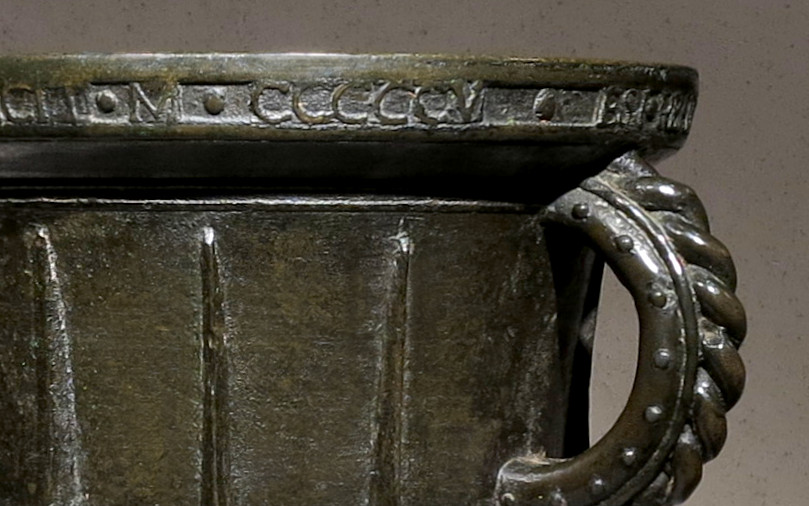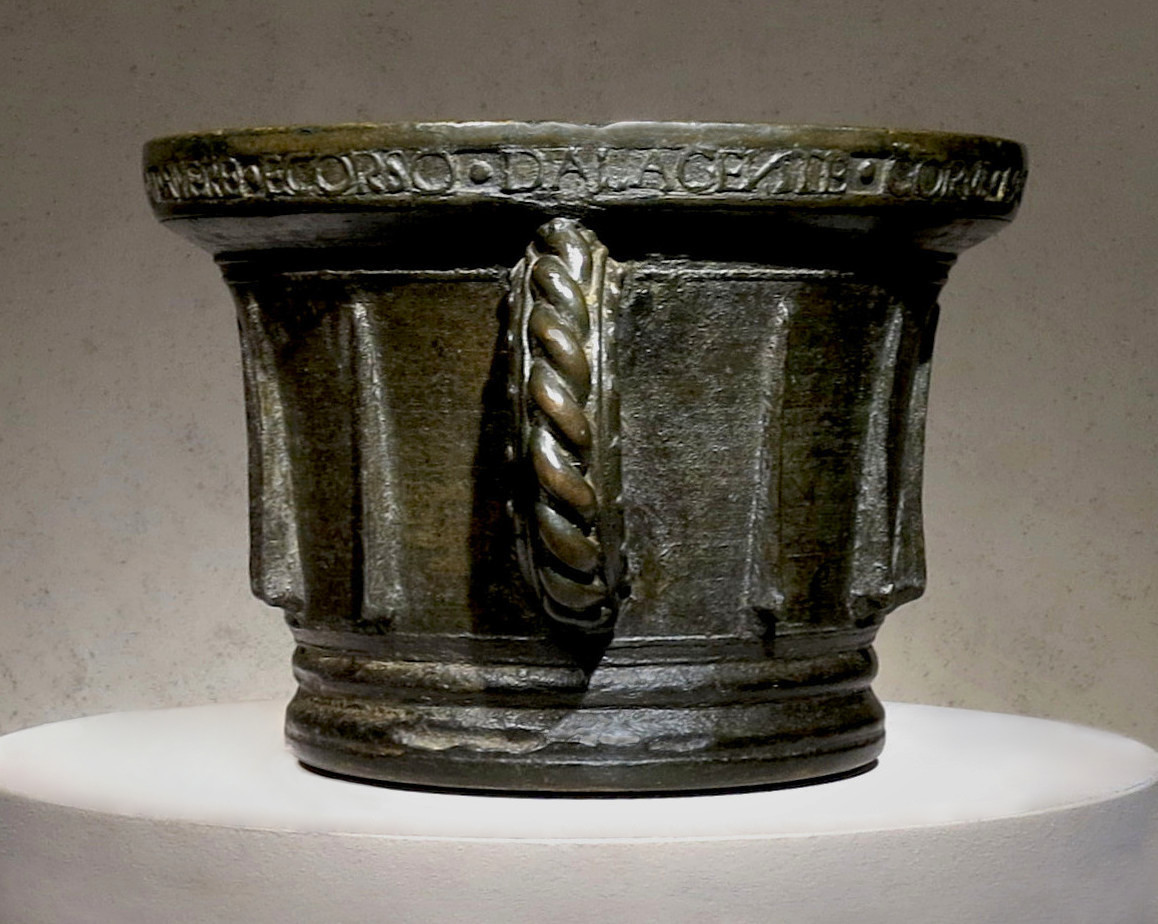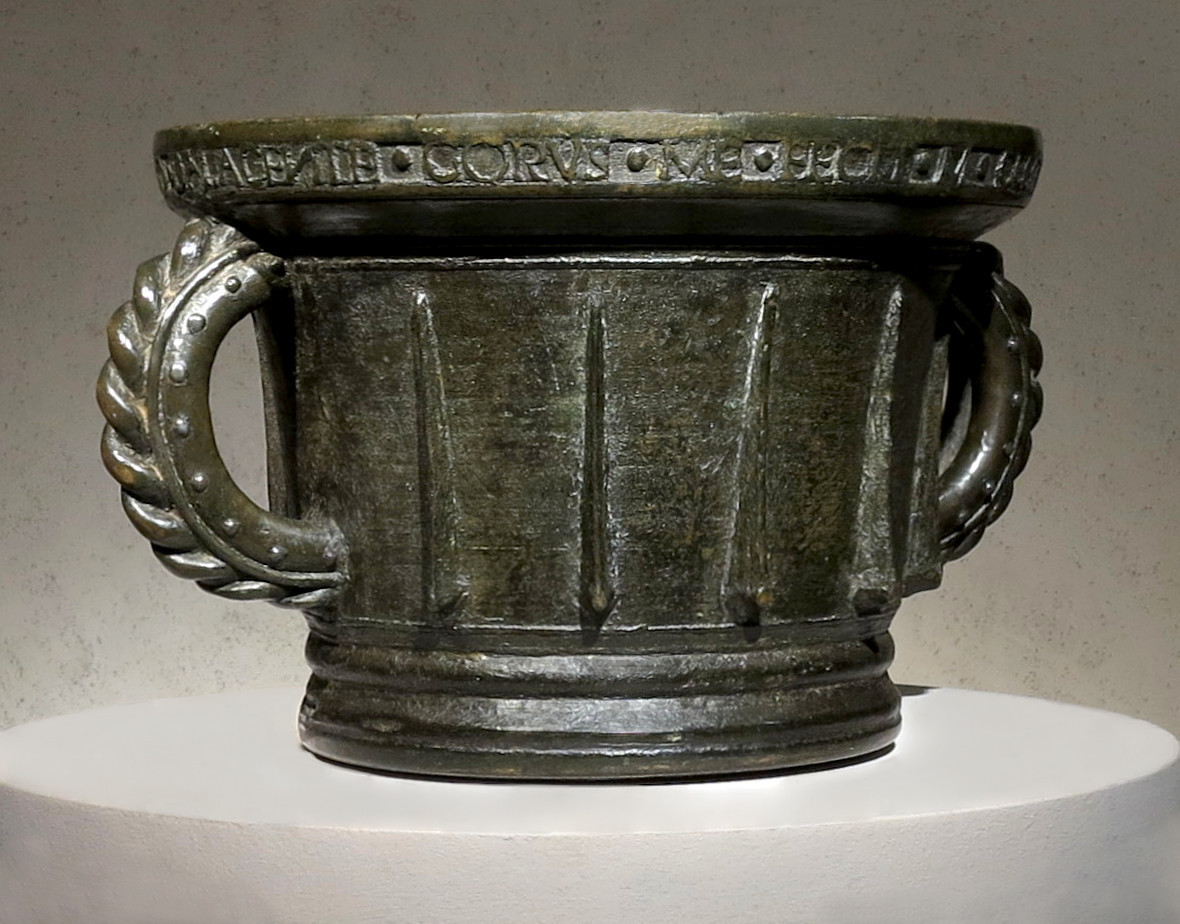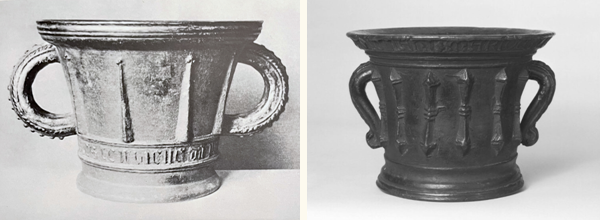
Gorus Me Fecit
The history of the mortar (from the Latin word mortarium, which in turn derives from the Sanskrit root mrdi = to grind or pound, and finds almost identical correspondence in the major European languages) certainly has its origins in the earliest antiquity, if it is true that the first tools for grinding or pounding date back as far as the Neolithic period.
Wherever mankind needed to grind a substance, there was a need for a mortar with its pestle: essential tools therefore in the domestic sphere for the preparation of many foods, although the best-known use is undoubtedly in the pharmaceutical, cosmetic and alchemical fields.
As with many other utility items, the great diffusion of this object took place in Europe from the Middle Ages onward and especially in the Renaissance and Baroque periods, with different and articulated materials, shapes and decorative patterns depending on the place of production.
While mortars made of wood, stone or marble are generally of rather simplified workmanship, those made of bronze, on the other hand, are often distinguished by high formal and aesthetic standards, so much so that they are rightly considered to be true objets d’art.

The remarkable bronze mortar presented here is characterized by a truncated cone-shaped vessel body – fitted with two mighty cordoned and studded semicircular handles and a shallowly shaped foot – adorned with ten cusped vertical ribs of Gothic reminiscence, following a rather precise and widespread pattern in the Tuscan and Umbrian areas between the 15th and 16th centuries; a model adopted, for example, by the famous mortar founder Crescimbene da Perugia.
On the upper edge of the mortar appears the following capital inscription: GORUS • ME • FECIT • M • CCCCCV • ESI • REALE • ENOFSARE • NIETE • SEVOI • AVERE • ECORSO • DALAGENTE; this phrase with a enigmatic meaning could be interpreted as follows: “Goro made me in 1505, and so authentic, and don’t falsify anything if you don’t want to have punishment from people”, a kind of prior warning addressed to the future user of the artefact.
The maker of the mortar is thus such a Goro, who turns out to be a well-known and celebrated Tuscan founder since his name also appears on another important bronze work: the clock tower bell of the well-known village of Chianciano, south to Siena.

The inscription on the bell reads: “UT COGAM CONSILIUM CAUSARUM TEMPORA DICAM OFFICIUM POPULUS IUSSIT ID ESSE MEUM – GORUS DE CLANCIANO ME FECIT ANNO DOMINI MCCCCCVIIII” that is: “The people have ordained that my task is to announce the times of the causes – Goro of Chianciano made me in the year of our Lord 1509”.
As is well known, the founding technique of bells and mortars is almost identical, so it is not strange that both bronze works were made in the workshop of Goro, while it is interesting to note that both of the two cited inscriptions are particularly rich and imaginative, differing from the rare and impersonal texts that usually adorn mortars and bells, where in many cases – but not always – the name of the maker, the date of manufacture and sometimes the name of the patron are simply given.
Specially, the presence of such a strong sentence on a mortar makes this work truly unique and rare.
Historical sources would indicate that Goro is the most prominent representative as well as the progenitor of an important family of master bronze casters active throughout the 16th century in southern Tuscany: from Goro who cast the first clock bell, to Leonardo di Goro – the son – to whom the city entrusted the care of the clock mechanism and its installation, to his grandson Luca Alberto di Goro, who replaced the clock and made a new bell for the tower.

Among mortars similar in type, quality, and area of origin, we can mention the one signed by Crescimbene da Perugia in the Camillo Castiglioni collection and the Tuscan specimen, signed by Giuliano Mariotto De’ Navi and preserved at the Victoria and Albert Museum in London.

Gorus de Clanciano (active early 16th century)
MORTAR
Bronze
Italy
1505
Cm 34 x 20.5h
Inscription on the rim: GORUS • ME • FECIT • M • CCCCCV • ESI • REALE • ENOFSARE • NIETE • SEVOI • AVERE • ECORSO • DALAGENTE
© 2013 – 2023 cesatiecesati.com | Please do not reproduce without our expressed written consent
Alessandro Cesati, Via San Giovanni sul Muro, 3 – 20121 Milano – P.IVA: IT06833070151